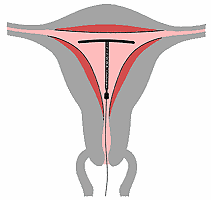|
Contraception
|
|
Methods of Contraception: Contraceptive Methods for Women
|
|
|
|

|
|
IUD in place.
|
|
|
IUDs
Intra-uterine (contraceptive) devices, or IUDs for short, have been known since ancient times. However, in recent years new types of these devices have been developed. A modern intra-uterine device is a small piece of flexible metal or plastic with nylon threads attached to the bottom. As the name indicates, it is inserted by a doctor into a woman's uterus where it prevents pregnancy. Intra-uterine devices come in various shapes and sizes. Today, the most IUD is a small T-shaped device, available in two basic versions: Some continuously release copper, others release the hormone progestin. |
|
At present, there is still no satisfactory explanation of how the IUD works. Perhaps it somehow keeps the sperm cells and the egg from meeting under the right conditions, or it prevents the fertilized egg from being implanted in the uterine wall. Several other theories have been suggested. Only one thing is certain: The IUD is very effective as a contraceptive device as long as it is in place. It can be worn for years without interruption and, of course, it can be removed at any time if the woman wants to become pregnant.
However, not every woman will tolerate an IUD well, and therefore a doctor’s prior examination and advice are essential. In certain cases, particularly if the woman has not yet had any children, the IUD may cause severe cramps and bleeding. This may force the doctor to remove it. Many women, however, adapt easily to the IUD after some initial discomfort. . However, even when there is no problem, the device may slip out without the woman's knowledge. It is important, therefore, to check its presence after each menstrual period by feeling for the nylon strings which reach a little way into the vagina
Effectiveness: very effective.
|
|
|
|

|
|
Various shapes of IUDs. The first one from the right has a hormone-releasing thicker stem.
|
|
|
|